June 13th 2023, Nelson, British Columbia.
It is mosquito season right now in Canada, and sometimes, especially close to a river in the early evening, the little bastards really have a field day. That was the case when I pulled into the Kettle River RV park and campsite, a beautifully lawned and well-maintained stopover in south central BC, almost on the border with the US. It had excellent showers and a laundry room with a table and chairs and wall sockets to recharge my phone and laptop. More importantly, the laundry room was an escape from the early evening mosquito hell. And good god, when they’re around, you really know about it. It’s like you are being eaten alive, especially on your arms, neck and face, and lower legs if they’re uncovered. Luckily, I have face mesh which works very well but my arms remain exposed. So having got myself into the campsite, I put up the tent up and retreated to the laundry room to write. Later, when the time came to sleep, I made a dash for the tent, making sure to open and shut the entry/exit flap as fast as possible to keep the bastards out.
Next day, I set off fairly early but still, even at 8.30am, the attack squadrons were at the ready. Once on the road, however, I was fine . . . until Grand Forks when a different problem emerged, one of my own making.
The first I knew anything was wrong was when I saw the blue and red flashing lights in my mirrors. I had just gone through a crossroads junction which had a filter lane for turning left that was empty. I had nipped into it and, when the lights changed, nipped back into my lane to go straight ahead. A minor offence, judge, and no previous. The flashing lights were from an otherwise unmarked car of the Royal Canadian Mounted Police, the RCMP. I pulled over and a policeman, a youngish fellow who was initially quite stern, told me that I was wrong to use the left filter lane to pass cars queueing at the lights and also, that when I went off from them, I was about 10 km/h over the speed limit, which I almost certainly was but only because it was so low — 20 or 30 km/h, I think — and I may well have been doing 30 or 40. Again, not a hanging offence but yes, an offence.
The officer asked to see my licence and so I reached into my pocket and withdraw my wallet. But at that precise second, I remembered that my Irish driving licence was actually out of date, by about two months. Having turned 70 on April 9th, the licence expired on that date and, while I have already renewed it online, the fresh licence remains sitting at home. I suddenly envisaged having to explain all this to the RCMP officer and in the context of he already being tee-ed off at my driving. So, thinking quick, I placed my wallet on my top box (the luggage box immediately behind my back), something he did not notice or at least he never said anything, and opened instead one of the side panniers to extract my international licence, which was still valid.
He examined it and continued to scold me for my behaviour and then started asking about the bike and what I was doing, and then said he rode a bike as well. It was sort of an “I know how bikers sometimes do things they shouldn’t” moment as well as a “Hey, I am biker too! Tell me more!” moment. We chatted about what I was doing, about his job and I mentioned that as a child I had watched a TV series, RCMP, in which “the Mountie always gets his man”. Did they still have those lovely bright red uniforms, I asked. Yes, he said, he had his but it was only worn on special, or ceremonial occasions. The more we chatted, the more confident I was that I was through that gap in the hedge and, sure enough, after a few minutes more, he handed me back the international licence, while warning me to be more careful. “Especially on major roads,” he said. “We have special highway patrol officers and they are not as nice as me.”
Lucky let off, I thought as I resumed the ride and he turned off the road, back into the centre of Grand Forks and, I presume, his station.
The next town was Castlegar, the last one before my destination which was the city of Nelson. I wanted to get some serious mosquito repellent before camping another night and so pulled in beside a Castlegar pharmacy and sought advice. Canadian pharmacies are great at this — very helpful and with a common sense approach. Earlier, a pharmacist in Vancouver dispensed some prescribed medicine for me based on an out-of-date prescription from Ireland that I had on email, something US pharmacists absolutely refused to do. The Canadian however, having listened to my request, and my explanation of my circumstances, concluded, sensibly, that I was genuine and medical need should trump the strict application of regulations and so gave me the tablets. At Castlegar, I took the pharmacist’s anti-mosquito advice, selected a spray and went to pay.
Reaching for my wallet, to my horror it wasn’t there. My wallet! Gone, missing! Oh Christ. I knew immediately this was a mega-disaster; suddenly I felt cold. All my cards, debit and credit, my Press card and other ID, and about $200 US and Canadian in cash, all gone and not easily replaced from a remote part of British Columbia. But where had I lost the wallet? “Did you use your card already today,” asked the sympathetic pharmacy cashier. Yes, I said. I had had breakfast not far from the mosquito campsite and must have left it there. Apologising profusely, I left the pharmacy and running to the bike while racking my brain, my blood ran cold as I remembered taking it out for the RCMP patrol cop . . . And then putting it on the top box and not picking it up again, and not putting it back into my jacket pocket
The distance from Grand Forks to Castlegar is, I now know, 97.2 kms. It’s a good road, skirting Christina Lake and passing over mountains, with some curvy sweeps and no rough surfaces. But still, 97.2 kms and most of it done at, I guess in hindsight, at 80 to 100 km/h. I thought there was a good chance the wallet would have fallen off within a few feet of my restarting the ride after my encounter with the RCMP man. Hopefully, someone would have picked it up there and handed it in to . . . the police. My calling in to the station would be an interesting moment, I thought. Worst case scenario was that it fell off maybe after five or six hundred meters further along the road and the contents burst all over the place and were gone forever. Either way, I had to retrace my steps to Grand Forks PDQ and hope I get lucky.
As I ran up to the bike, and was about to put on my helmet when I saw: there it was — the wallet — sitting on the top box, where I had placed it, furtively, about an hour and 97.2 kms earlier. Folded over, nothing having slipped out, nothing missing. It appeared not to have moved a centimeter.
Crisis over.
I still can’t really believe my luck. I have since placed it back onto the top box to see if the surface is slippery or sticky. It’s neither really; it is a little sheltered by my rucksack, which sits on the pillion seat and is strapped to the top box. But even still, for the wallet to have remained there, over that distance, and not fallen off is extraordinary. And for it to be retrieved after all that, well, that has to be one of the wonders of this entire journey.
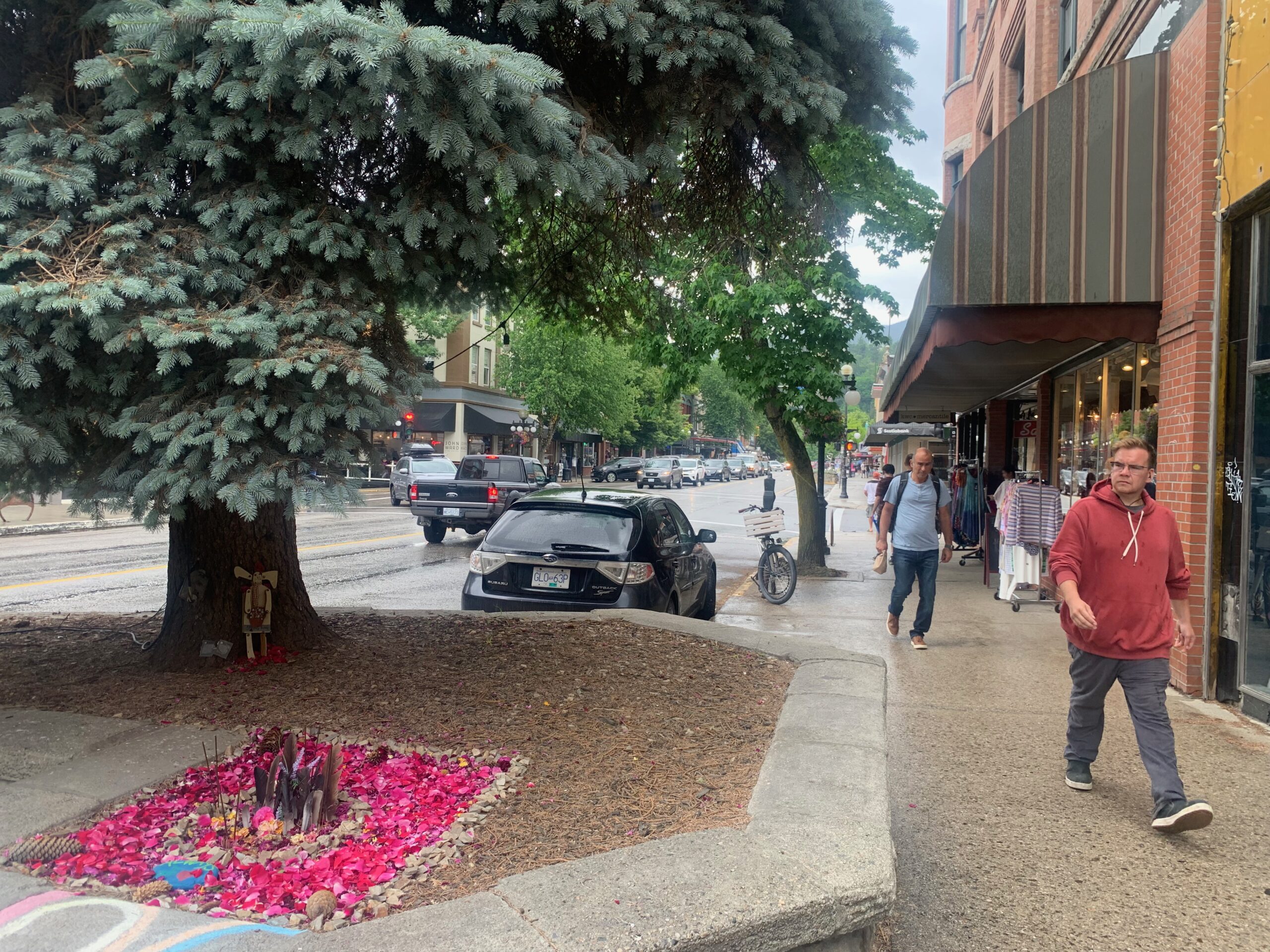
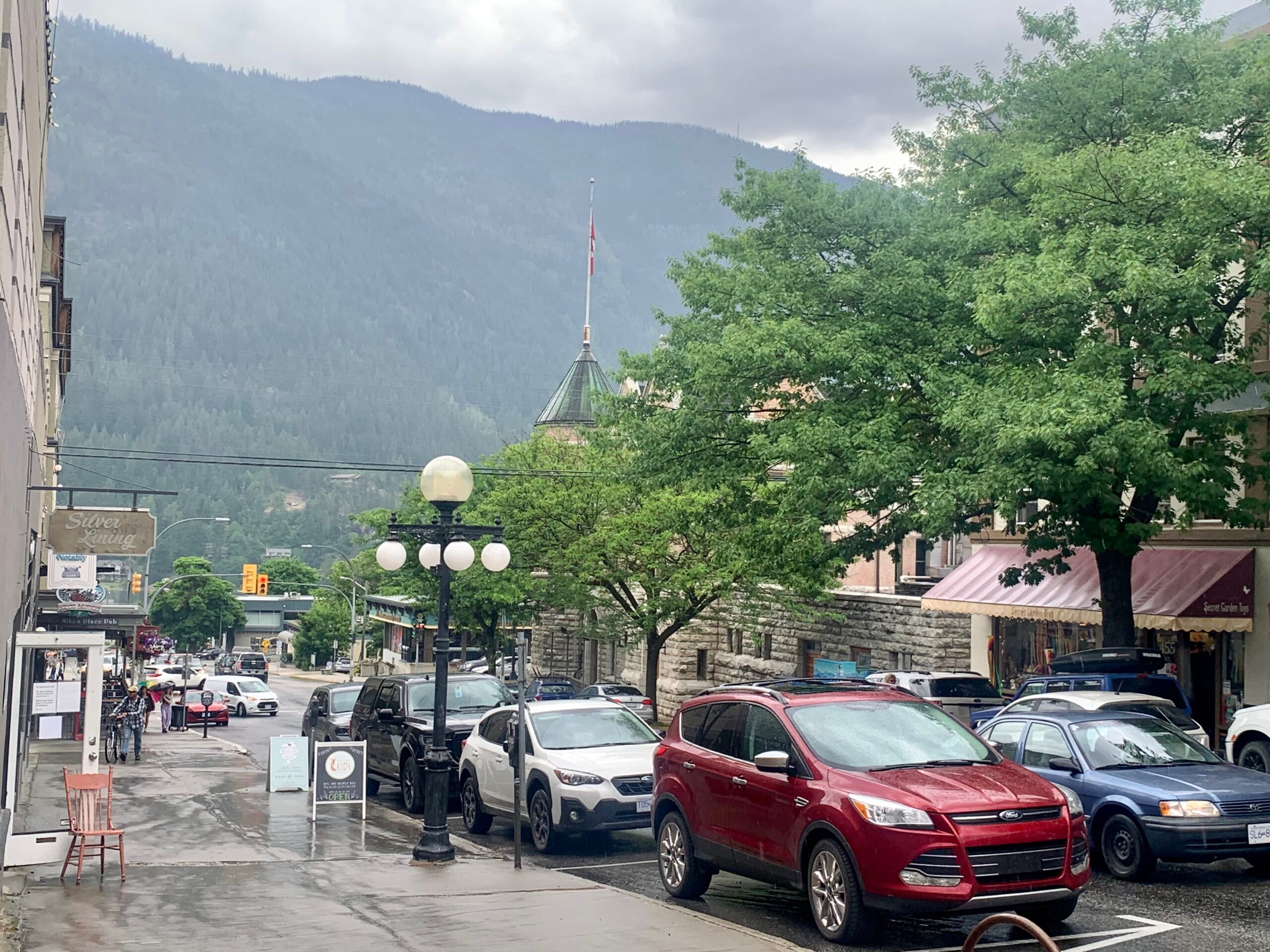
And so, somewhat against the odds, I came to Nelson, a lovely medium-sized city in the middle of the Kootaneys, a stunningly beautiful part of south-eastern British Columbia characterised by mountains, rivers and lake. Though it calls itself a city, for me really it is town-sized, with a population of som1 11,000 people.
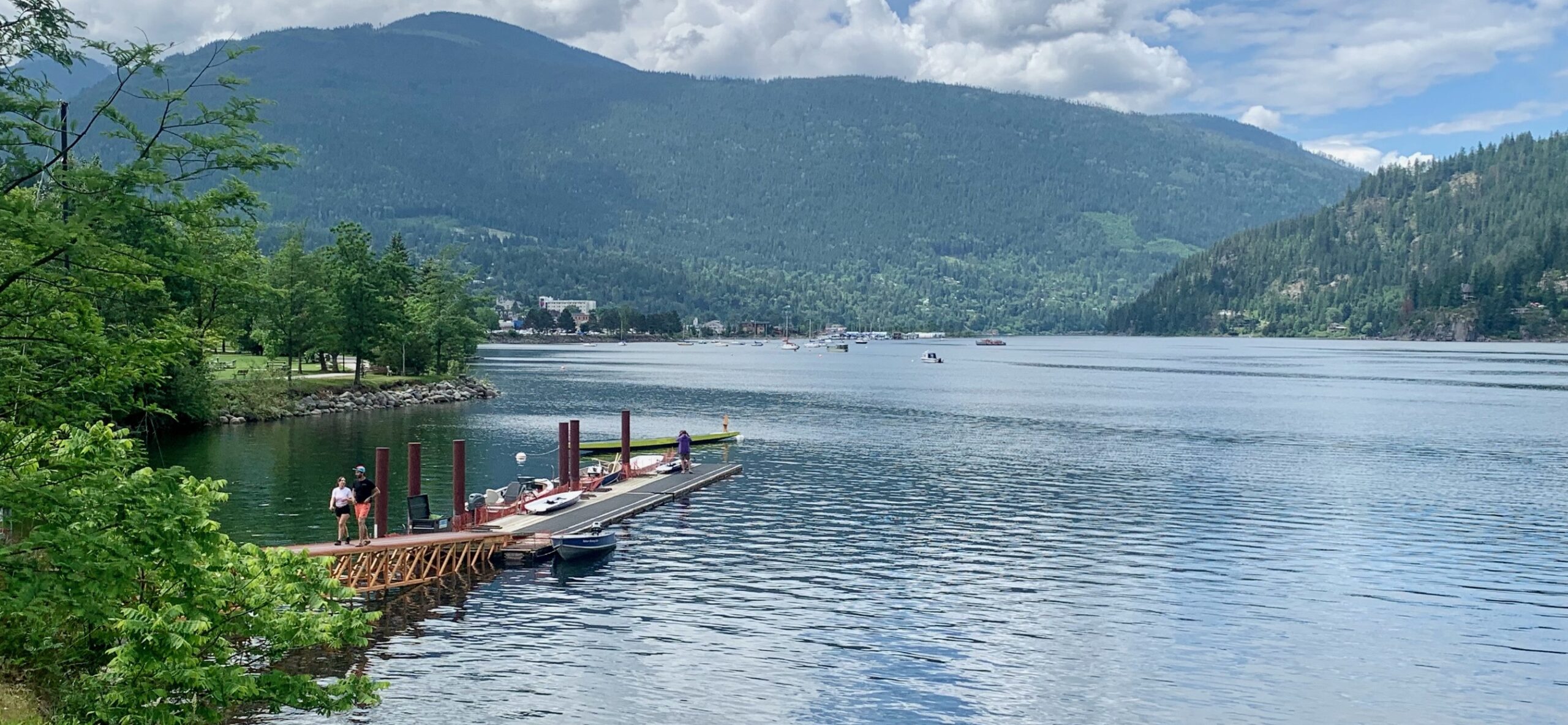
It sits on the Kootaney River, from which the region takes its name, before it flows into the Columbia River, the largest in the Pacific Northwest and the one I have criss-crossed since first meeting it at Astoria in Washington state where it enters the ocean. Nelson is famous for many reasons. It is a very, very pretty town and has featured in several films, notably was as the setting for the 1987 film Roxanne, starring Steve Martin and Daryl Hannah. The Kootaney is quite wide at this point, about 500 meters across, and is more like a long, slender lake; in fact, the town refers to it as Kootaney Lake West. The town is on one bank, looking across at a steeply rising pine tree covered rocky mountainside rising from the other bank. The mountaintop is often shrouded in low cloud or early morning mist. Along the town side shore, there’s a boat marina and several jetties, and volunteers operate a little antique electric street car that goes up and down along the shoreline. It passes a perfectly kept linear park where children play ball games and older people relax on benches, most of them, like the trees, put there in recent years by local people marking Nelson’s centenary.
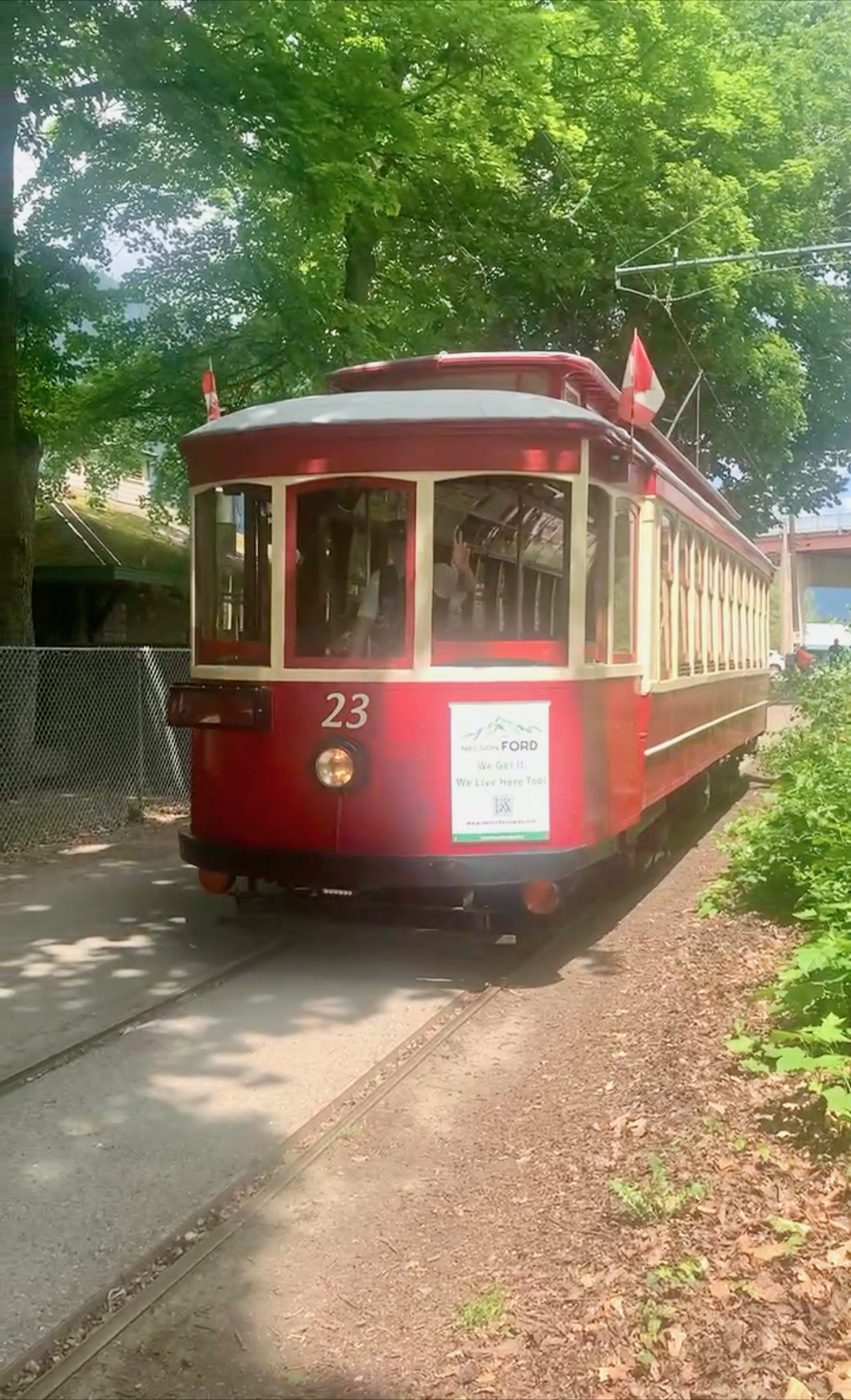
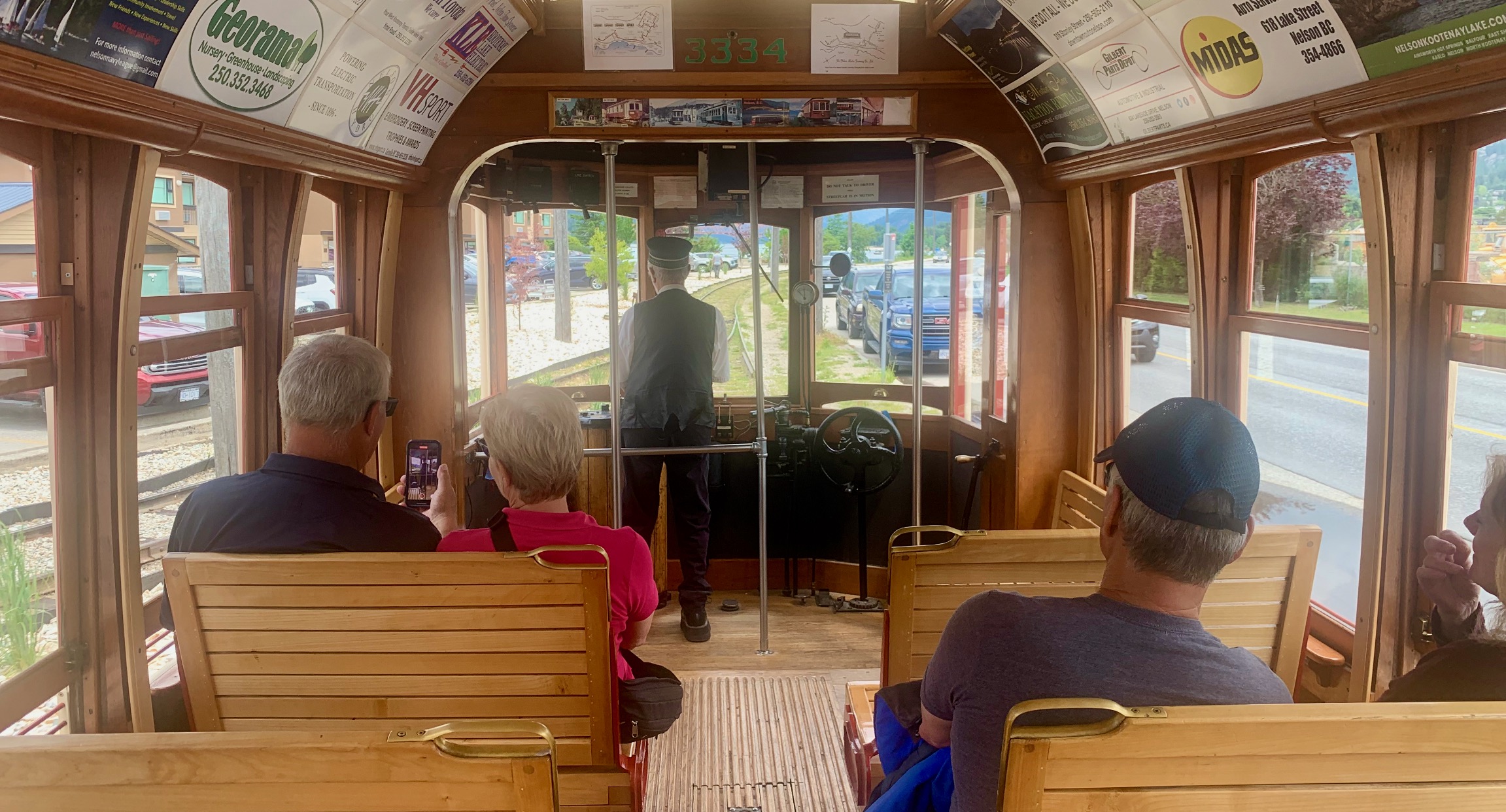
The whole town, but especially places close to the water or with water views, is sprinkled with cute, clapboard homes with shingle roofs, most of them kept pretty by their owners but a few looking run down and slightly hippy-ish. I’m including a larger-than-usual selection here, just because I think they are so lovely.
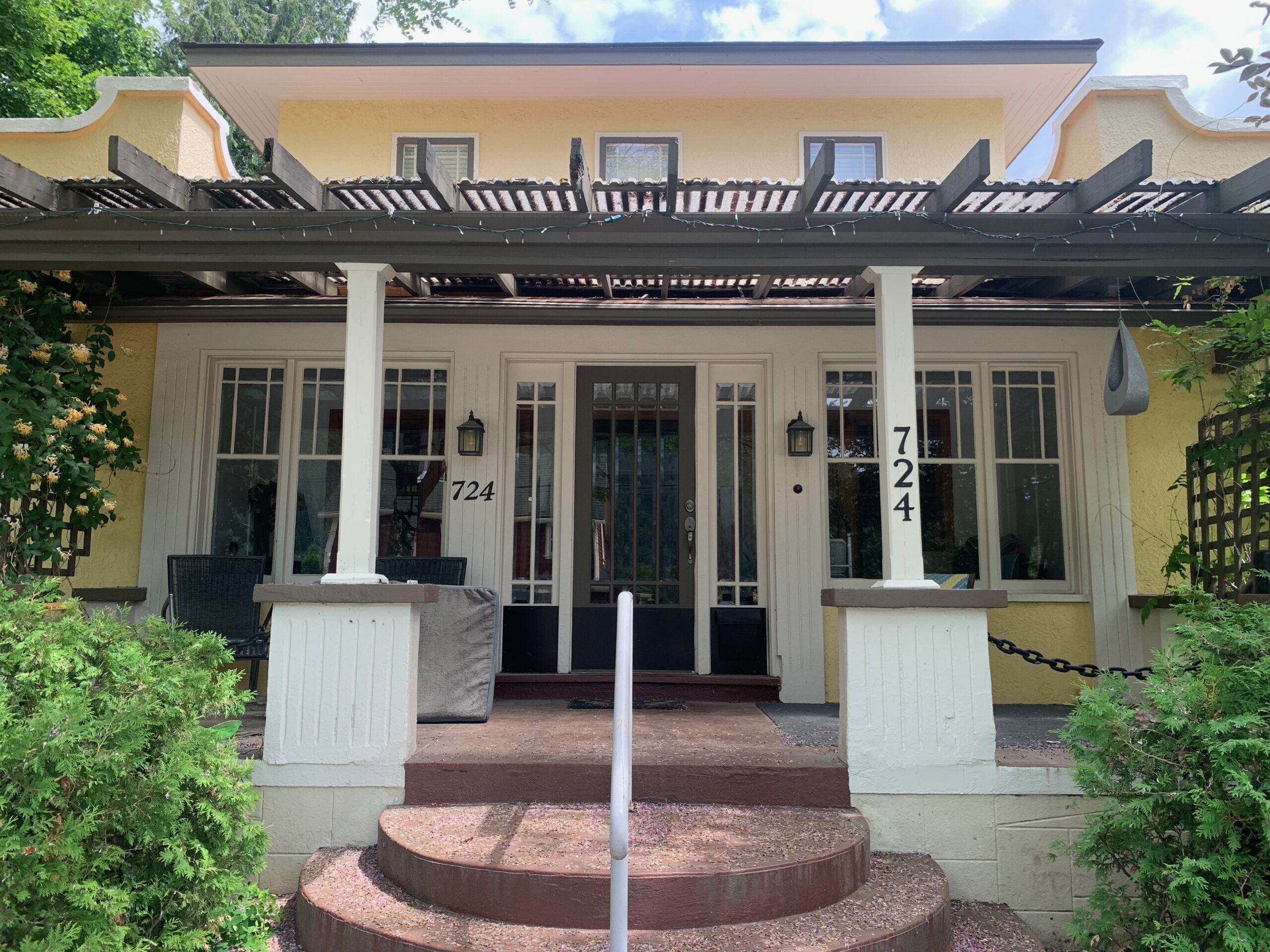
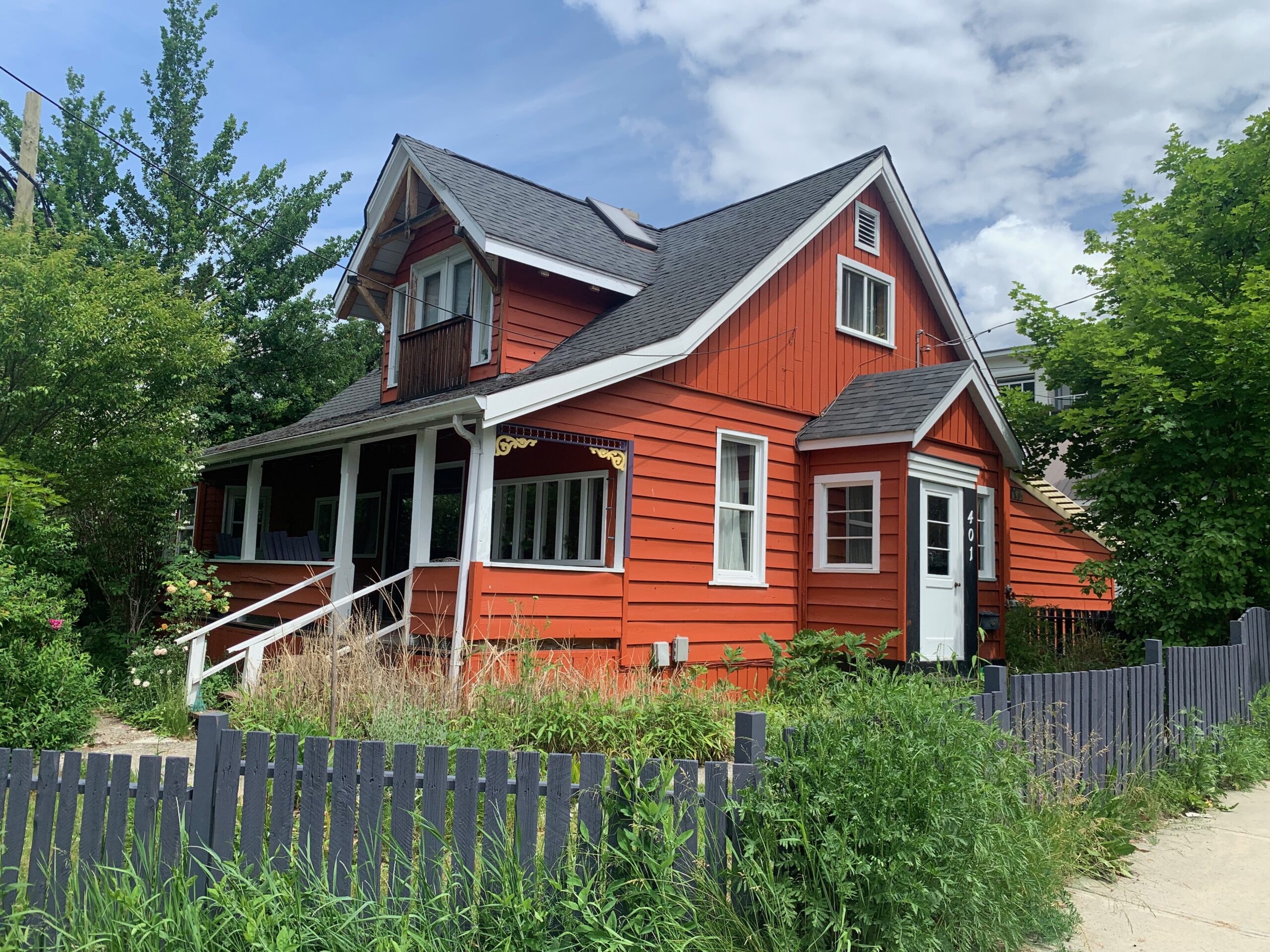
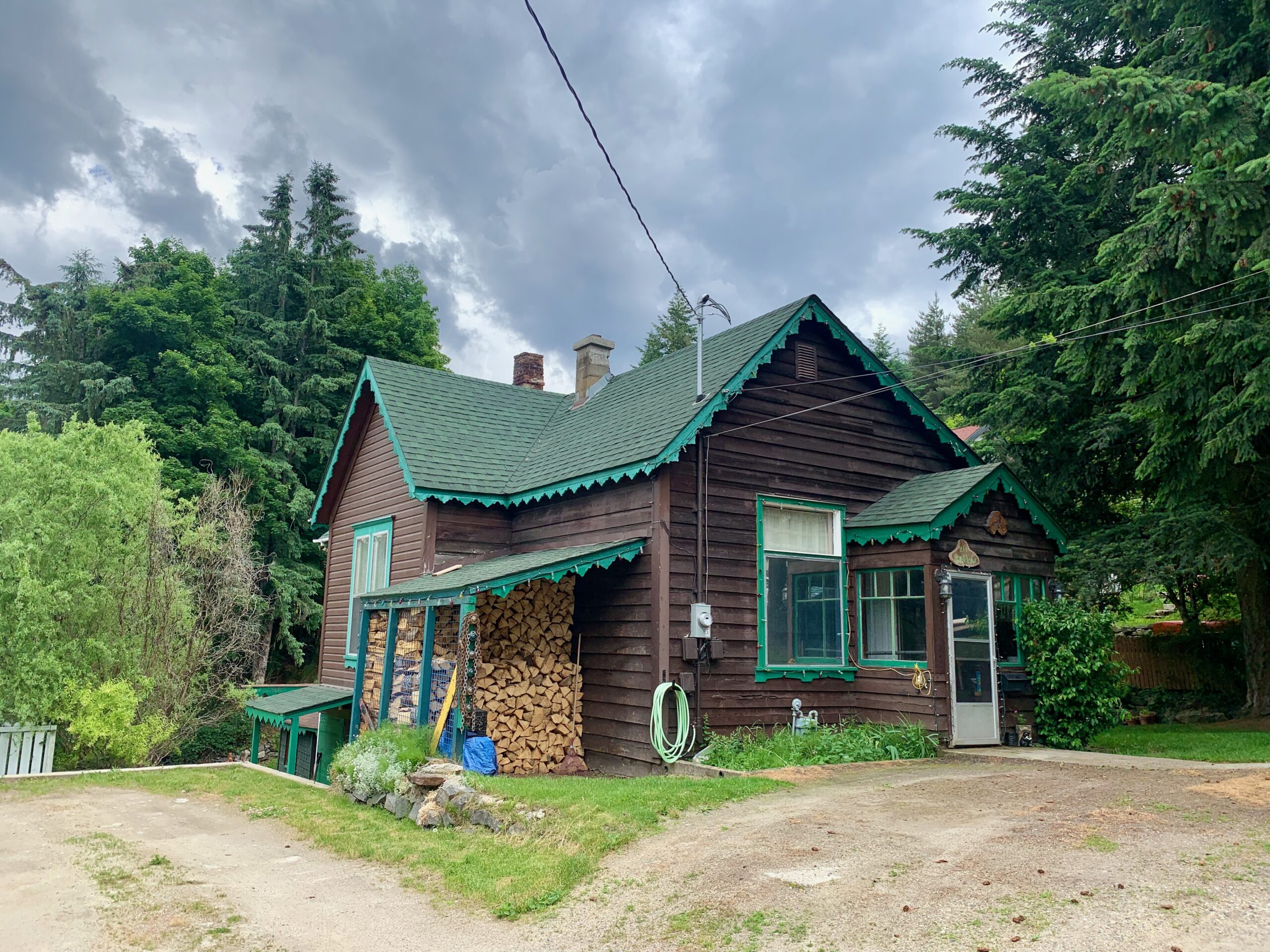
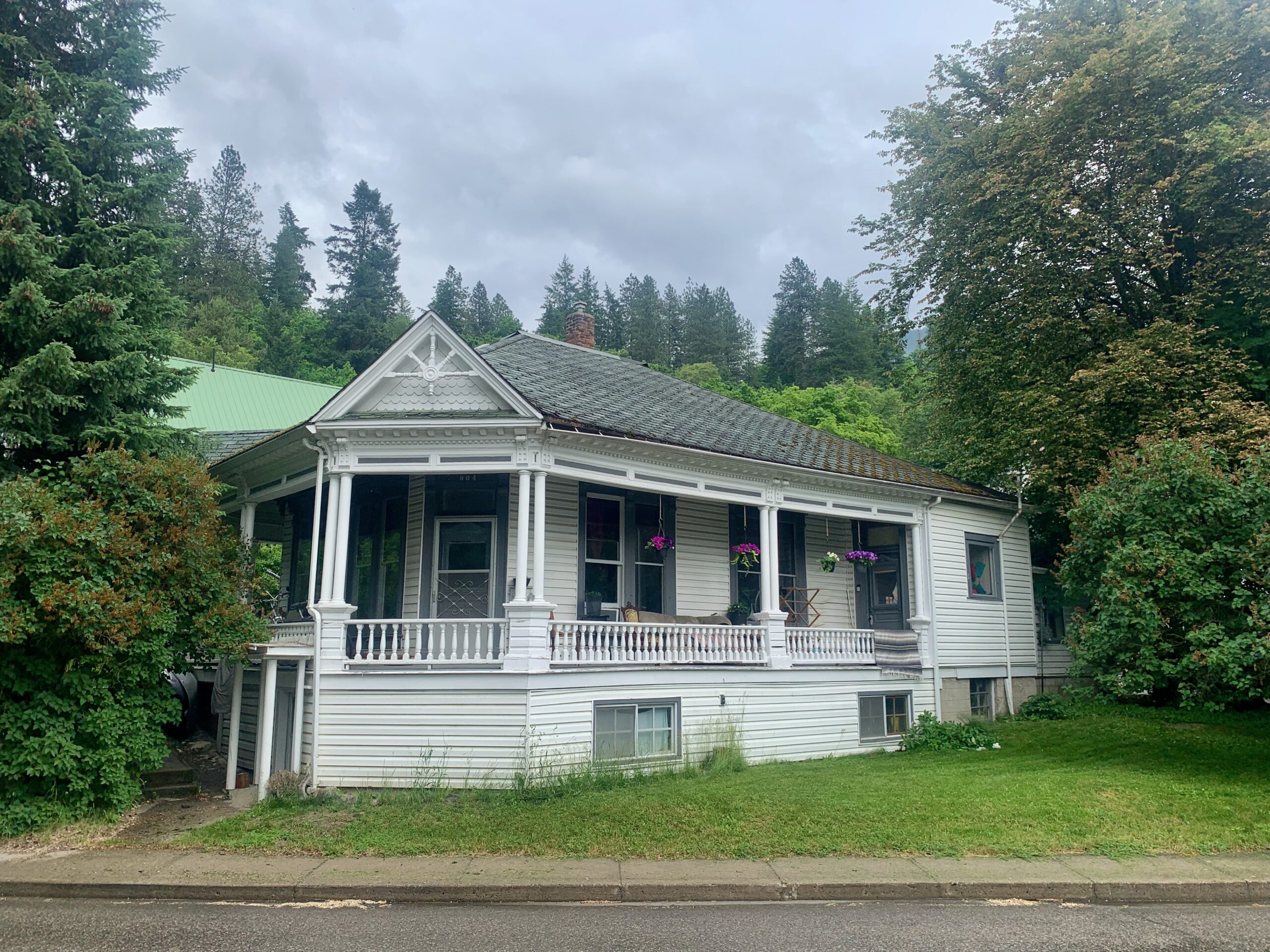
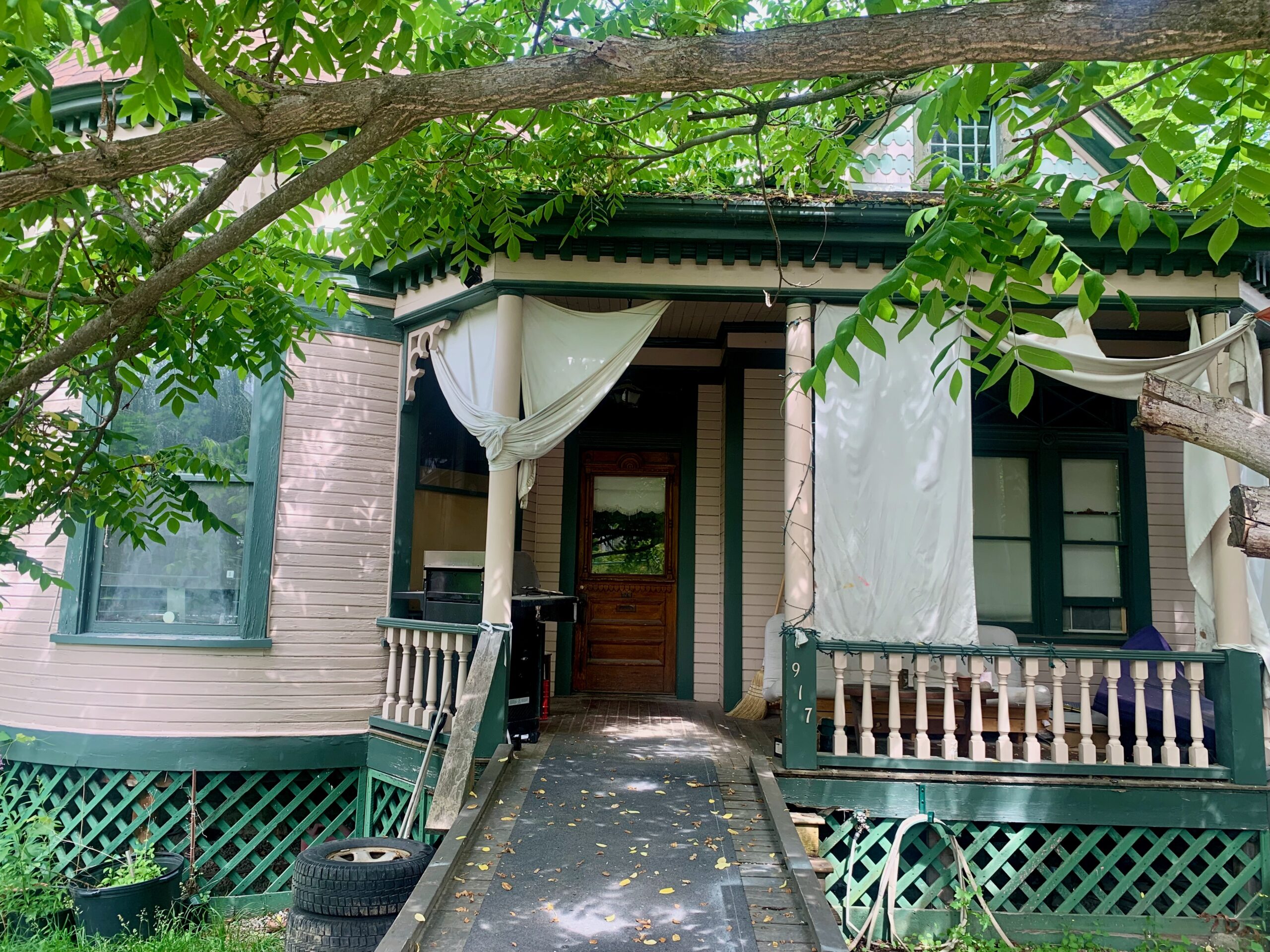
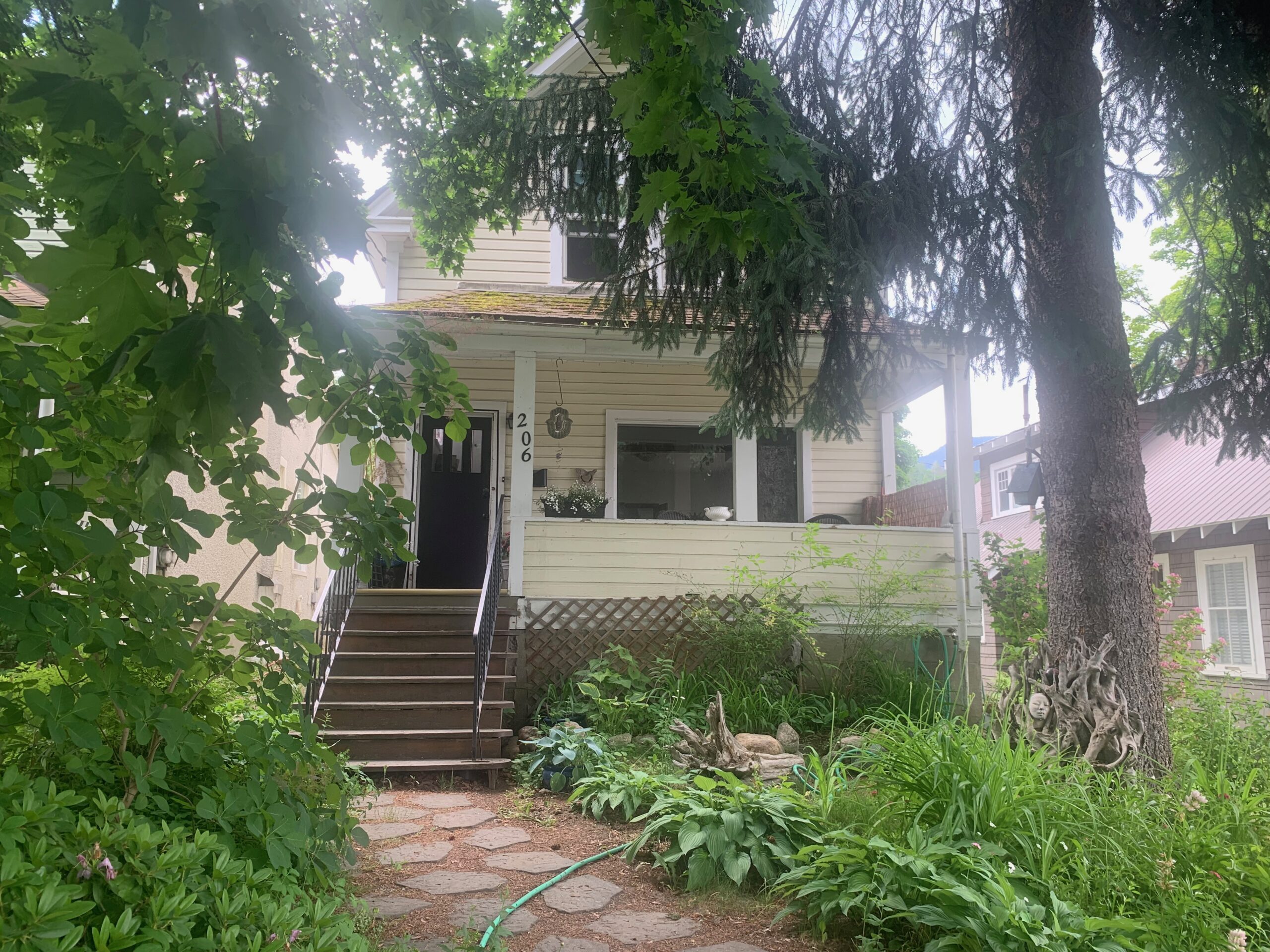
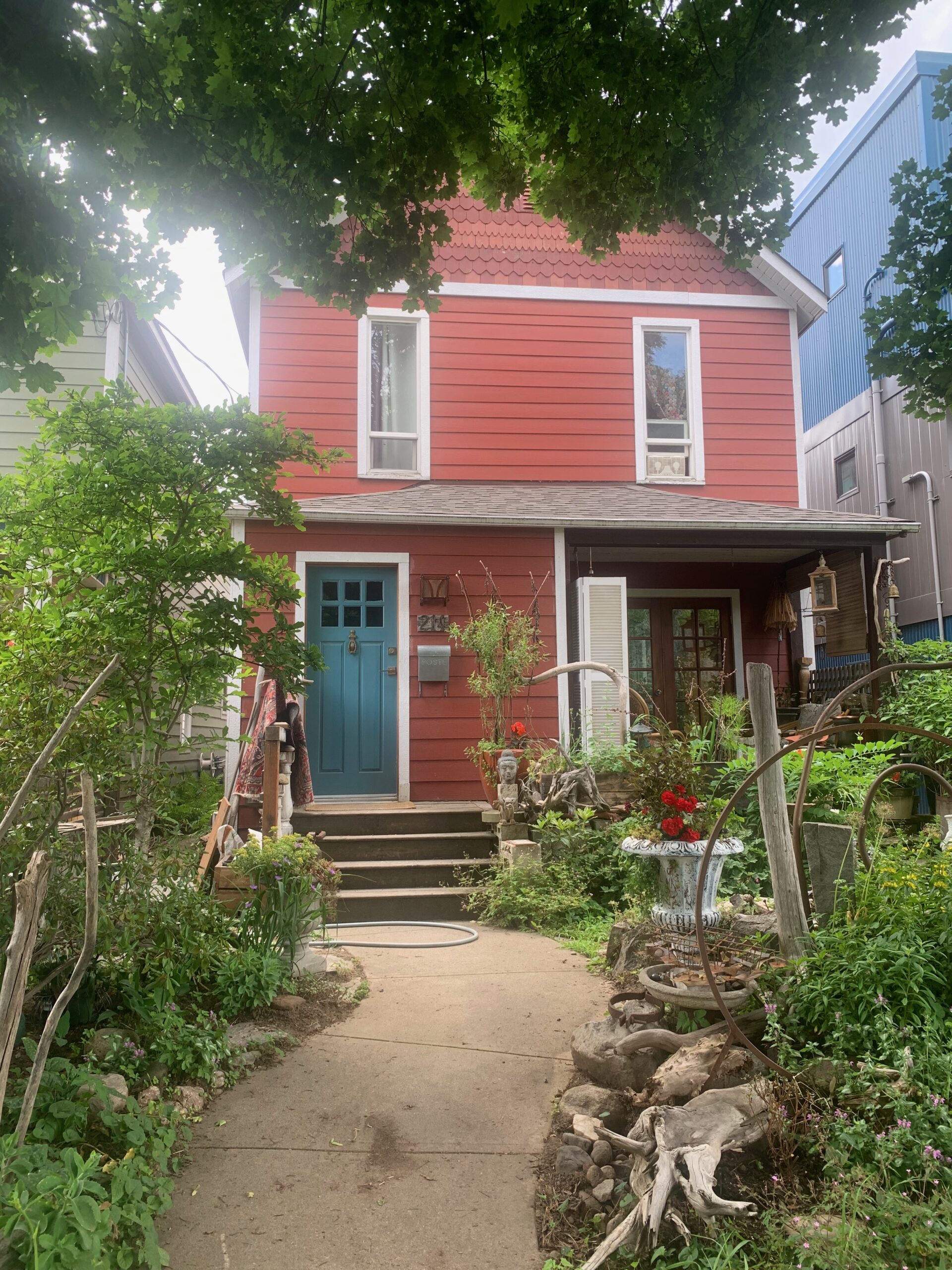
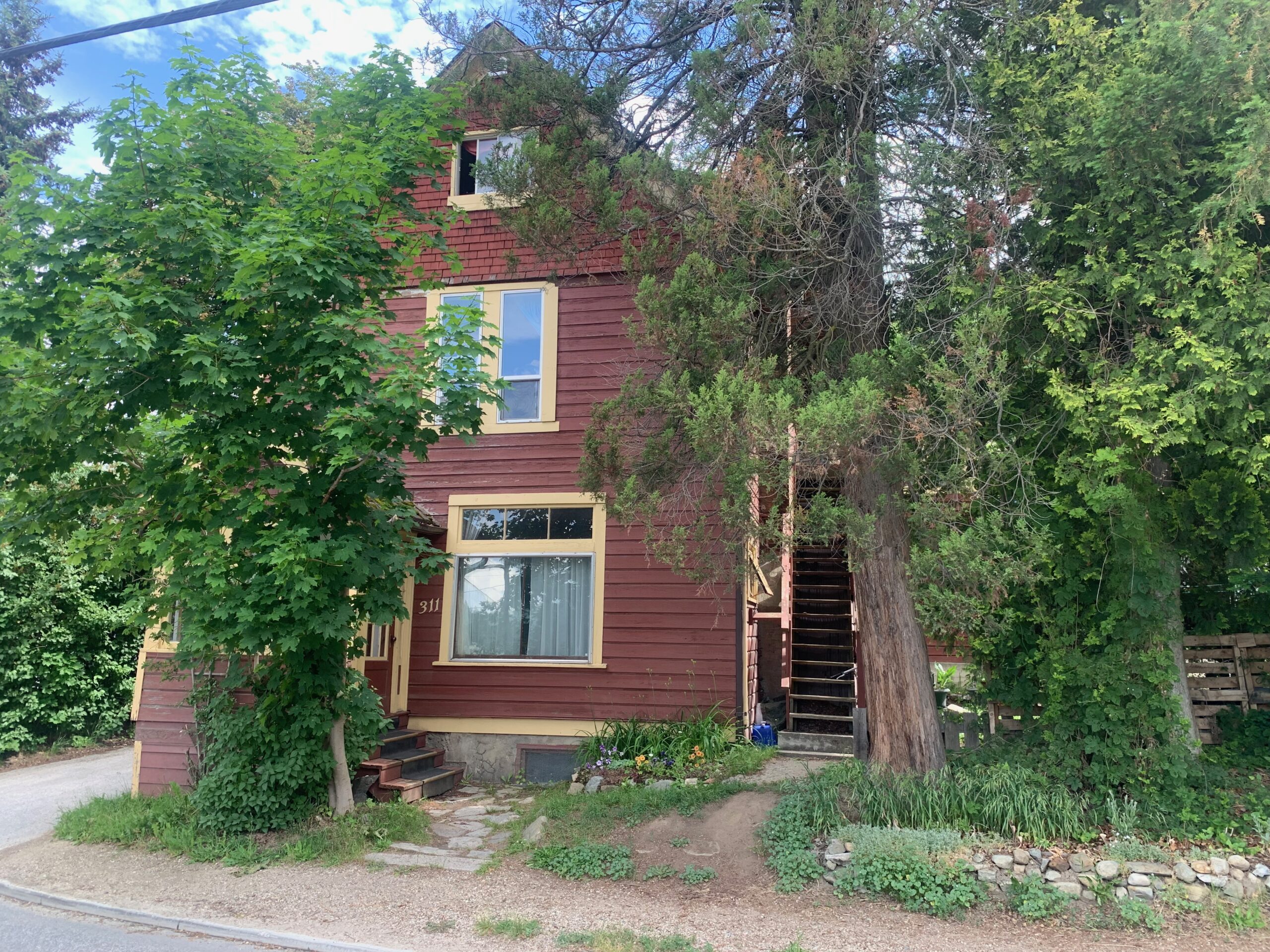
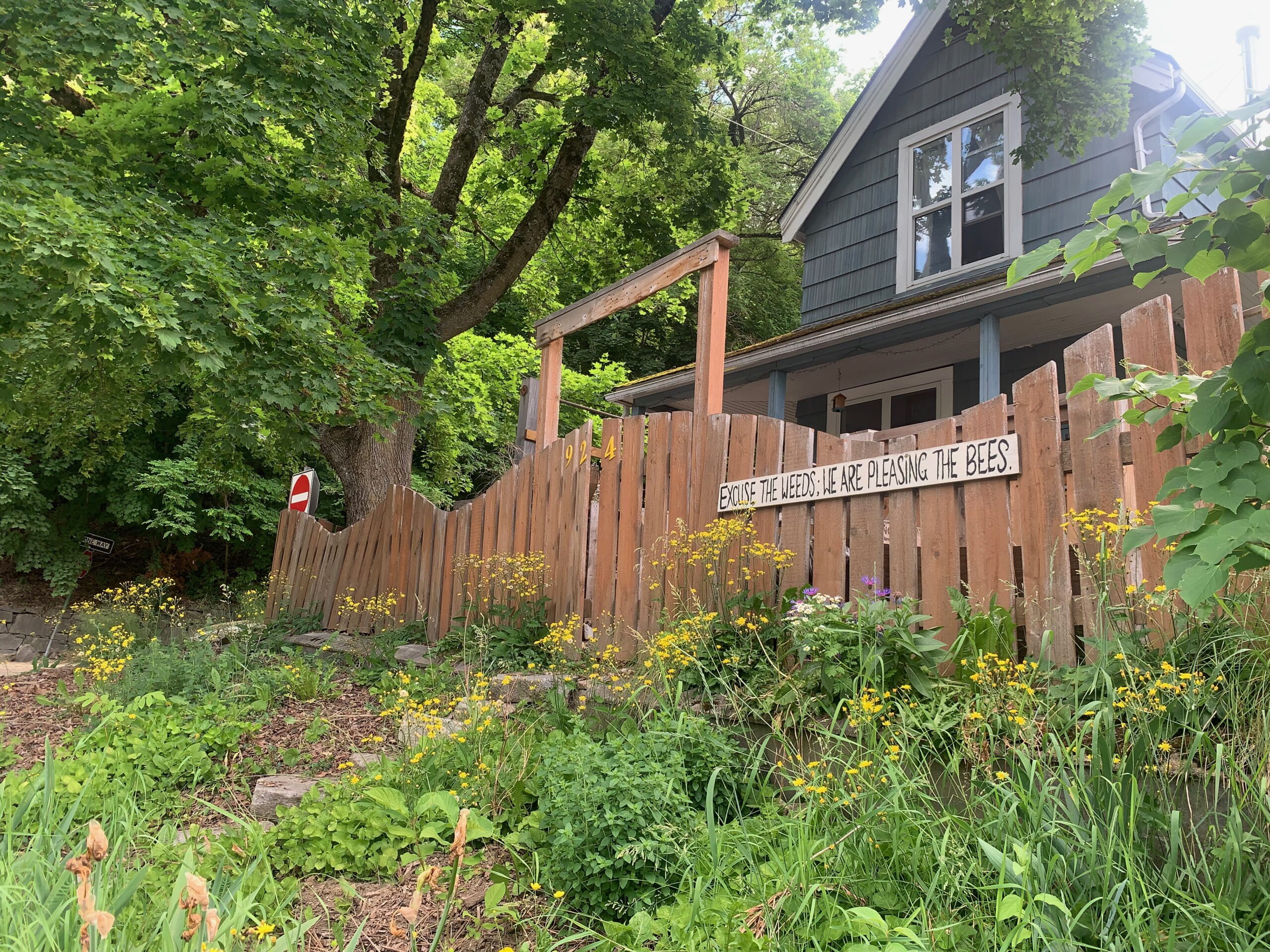
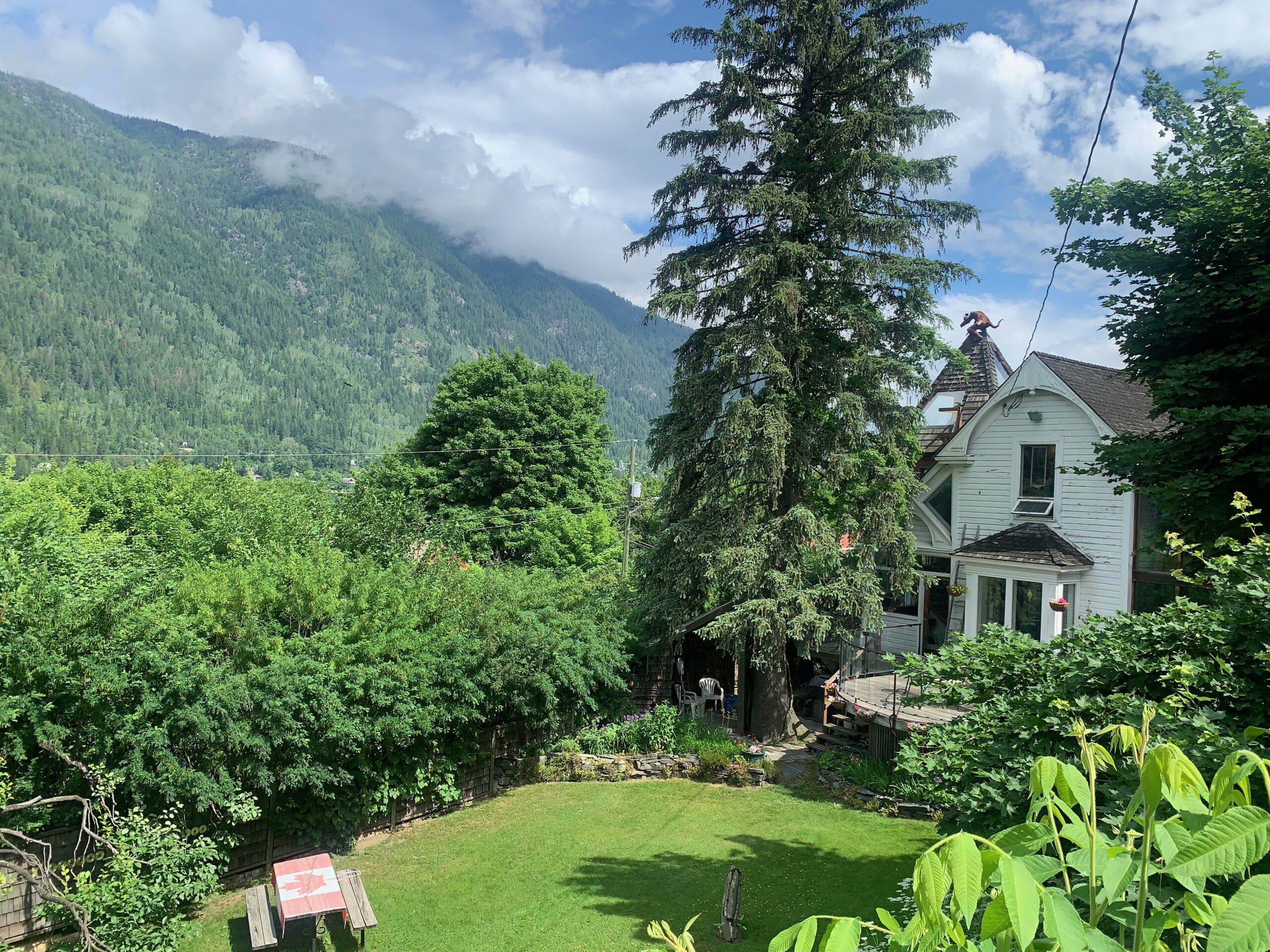
The best known street is Baker Street which is lined with carefully restored late 19th to mid-20th century buildings, cafes, bars and restaurants, and up market clothes and tourist shops. Most of the heritage buildings, which is most of the street, owe their existence to wealth generated by the surge, from the 1850s onwards, in logging and mining for gold, silver and copper.
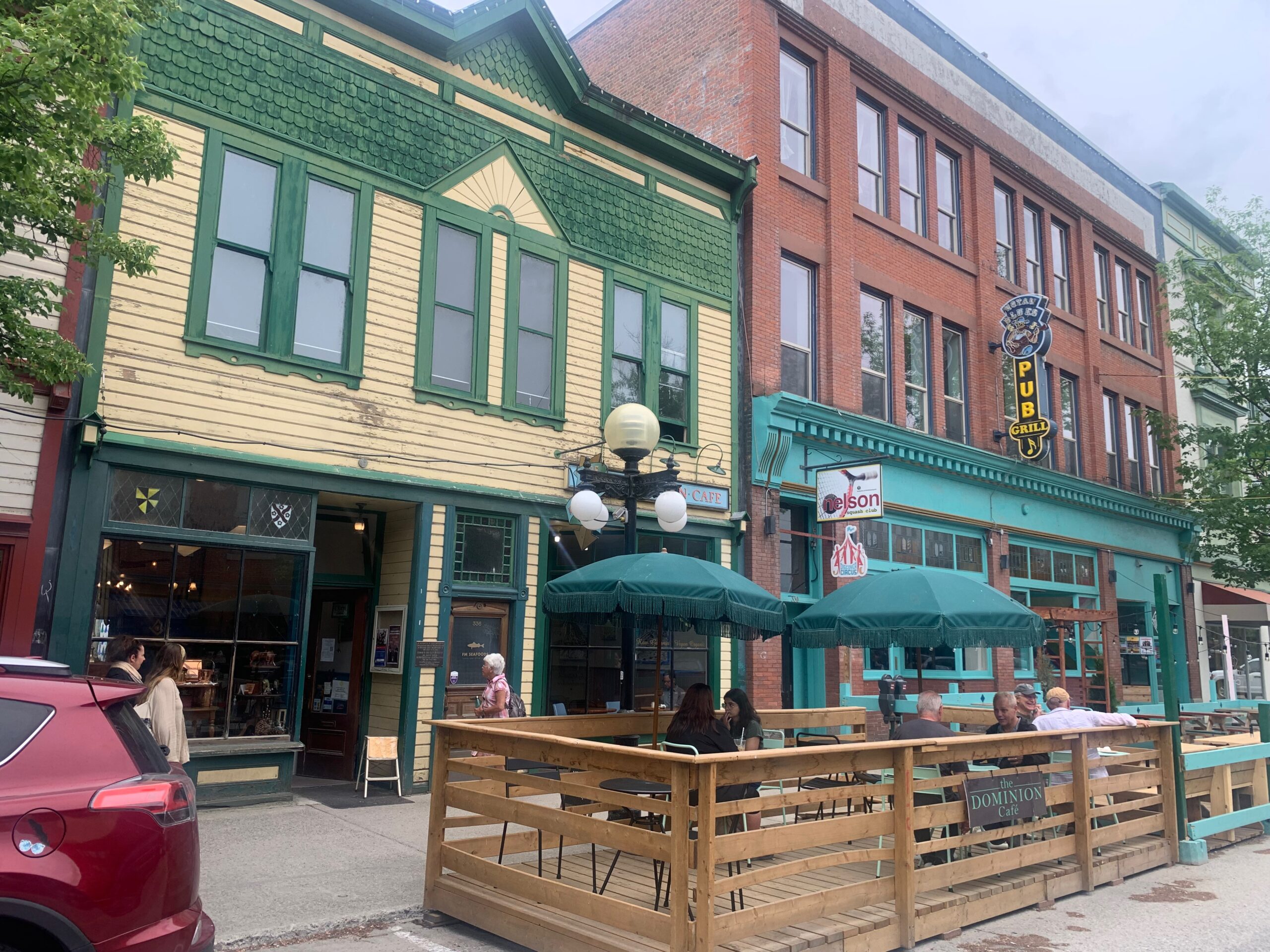
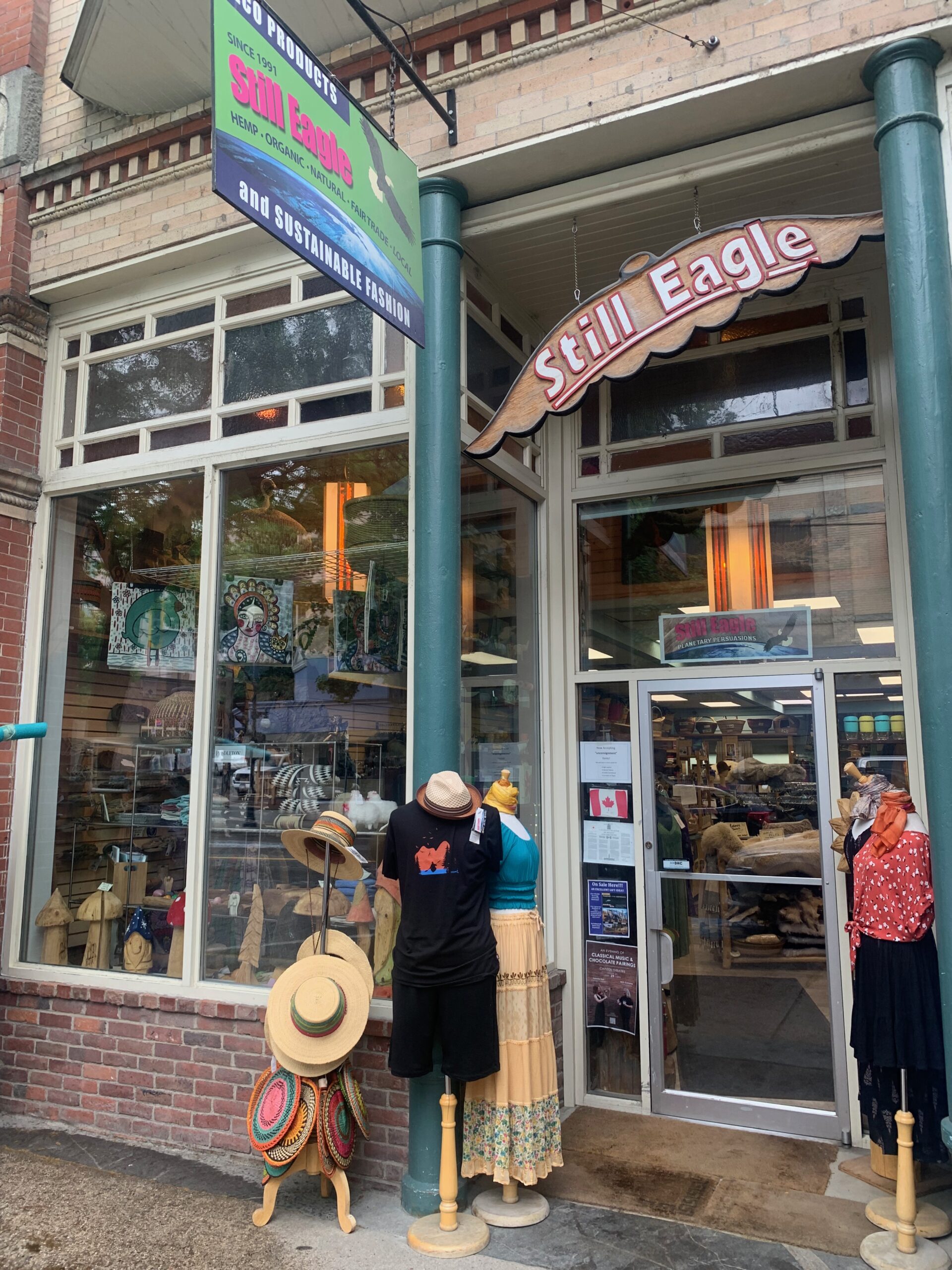
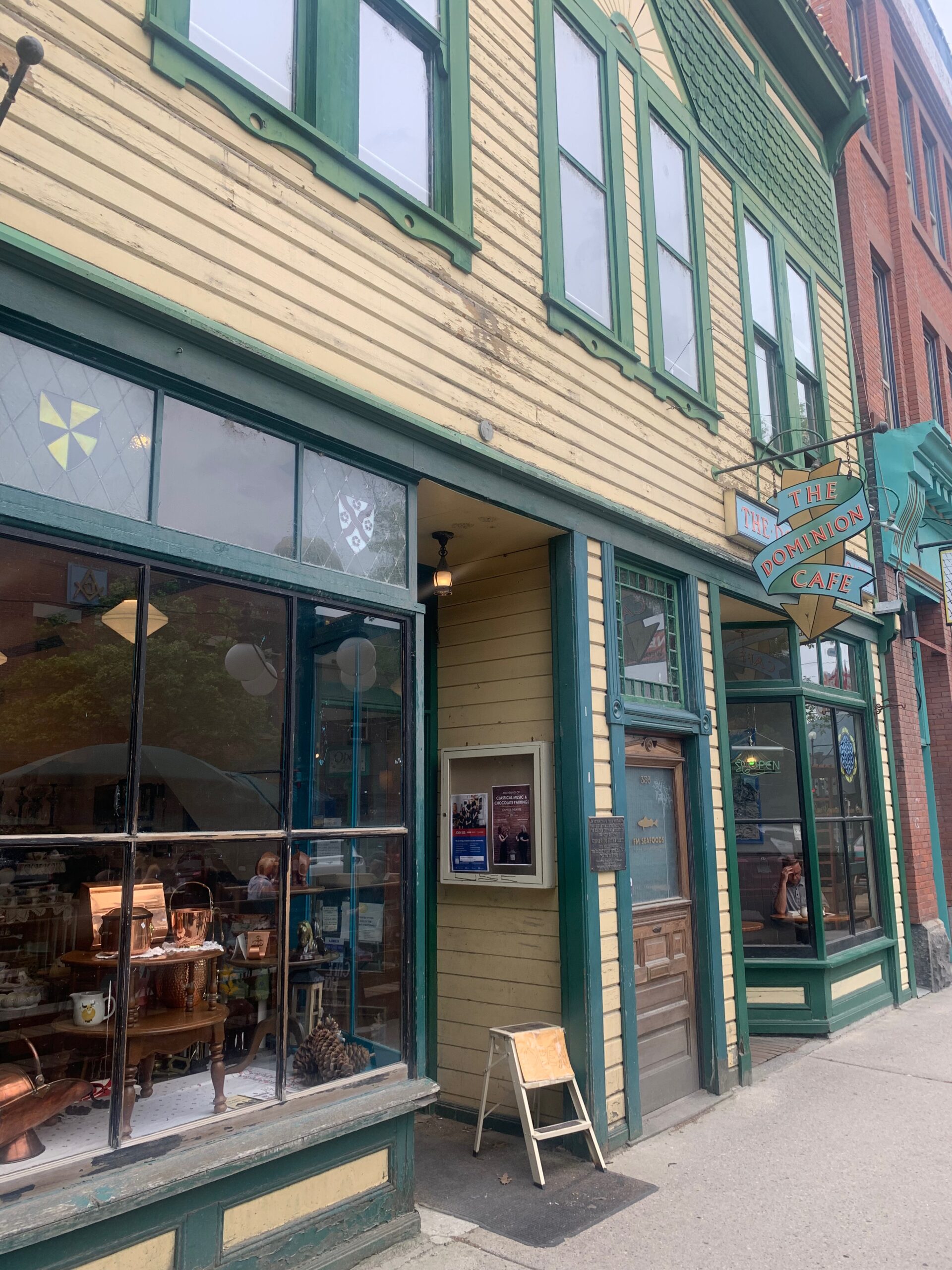
Europeans were here first in the early 19th century — as fur traders linked to the Hudson’s Bay Company and a rival, the North West Company. But the area was already home to the Sinixt, native Americans who suffered in much the same way as all other American indigenous peoples did when European origin settlers came their way.
The Sinixt have a lovely prayer, the Prayer to the Four Directions, that reflects their relationship with the natural world. It was recited traditionally by the chief who first would face East to acknowledge the creator — the sun who brings warmth, fruit, birds and animals, growth and happiness. Next, the chief faced North — the North changes the world, said the prayer, bringing snow which melts and washes away into the rivers all the deteriorated stuff from the land.
“That’s why we pray to the water, every morning and every night,” explained Snpaktsín (Breaking of Dawn), according to a panel in Nelson’s museum. “You talk to everything. Everything is alive. If it wasn’t for Father Water, nothing would live.”
Next, the chief would turn West. “That’s where everybody is supposed to rest. You become a new man, a new woman in the morning.”
Finally, the chief would turn to the South. “That’s where all the good comes from. The animals, the birds that leave for the south return, the fruit will come, the roots will grow, and the salmon will return.”
The prayer seems to me to be another example of how the native Americans, the first Americans, the Indians or indigenous peoples — I’m still unclear as to what is the most appropriate, or accepted, term to use — had a great closeness to nature and an appreciation of the value, to their own lives and to the earth itself, of respecting it.
Gold was discovered in Kootenay in 1854. The first European settler was a man named Richard Fry who came in the 1860s and married a Sinixt woman, Justine Susteel Fry, though Justine was hardly her original name. They had children and their descendants remain in the area, according to the Nelson museum.
Mining came and went but logging remains a huge part of the local economy. The Kootenay River has been tamed with dams and hydroelectricity generation stations, but by the 1920s, tourism, based mainly around mountaineering and winter sports, began to take hold. In more recent decades, Nelson has become a place of note for other reasons too: it has been a haven for retirees and for artists for some time and, in the late 1960s and ’70s, around 10,000 US draft dodgers crossed the border into Canada to escape the Vietnam War. I’m told that about half of them remained and made their lives in Nelson. “They brought with them their alternative, back-to-nature lifestyle,” says museum guide Jean-Philippe Stienne, “and that had a big impact on Nelson.”
Part of that legacy is that today, Nelson is also the capital of cannabis production in British Columbia . . . which is a story for another day.
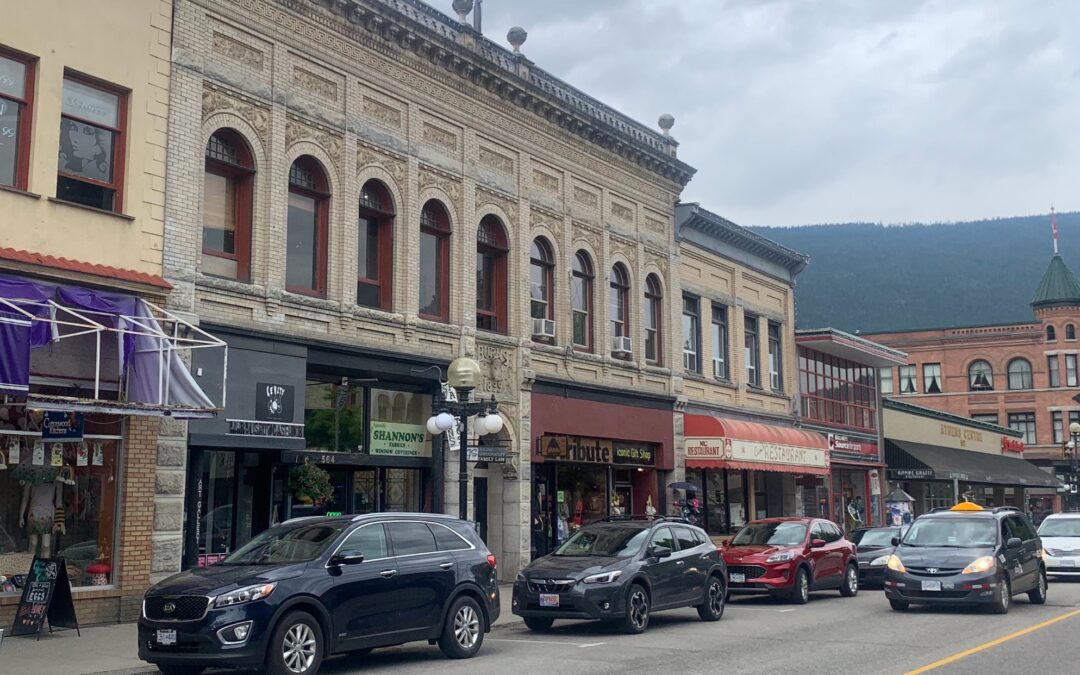
Lovely piece, and what a lovely place. Wish I was there. I know that chill of dread when you think you’ve lost your wallet and think frantically where you last saw it, but the obvious explanation for why it stayed put is because your vast wealth means it’s heavier than the bike 🙂
I’m glad it turned out well with the wallet.
Thoroughly enjoyed the piece. Safet travels.
Such craic altogether. Been to Nelson many times and the roads in the Kootenays are a bikers dream I can say with confidence – it’s a days ride from my home in Calgary so you’ll probably see many bikes from Alberta. Speaking of losing things I had to backtrack almost a full day in monsoon rain to retrieve my Irish passport / Bike Registration etc in Costa Rica – I’d stuffed my documents under the matress at a cheap hotel I was staying and rode off with nary a thought… until later in the day. As my dear Ma used to tell me “Jasus, but you’ve got a head on ye like a sieve!’.
Thanks! Went from Nelson to Jasper and am just about to post a long blog on that one… incredible scenery and fab biking country.
Have missed the past couple of weeks but am loving the final stages of this cracking blog.
Having recently had my phone lifted I can relate to the panic but what an incredible end to that episode.
So how does one acquire such a wallet?
God knows but you’re not having mine!!!